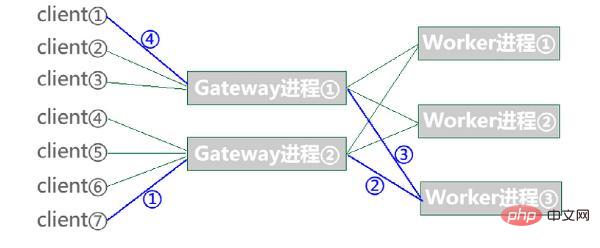 PHP Framework
PHP Framework
 Workerman
Workerman
 Detailed explanation of the startup process of workerman source code analysis
Detailed explanation of the startup process of workerman source code analysis
Detailed explanation of the startup process of workerman source code analysis
The following column workerman tutorial will introduce you to the startup process of workerman source code analysis. I hope it will be helpful to friends in need!

#workerman
Version: 3.1.8 (linux) Model: GatewayWorker (the Worker model can be compared with it)Note: Only part of the code to explain is posted, and the source is given in the form of a file name. You can check it out by yourselfworkerman initially only developed the Linux version, win was added later, and is run based on the command line mode (cli).Multi-process model
Worker process, Master, Gateway and Worker, Gateway is mainly used to process IO events and save client connection status. Send data processing requests to Worker and other tasks. Worker is a complete business logic processing. The former is IO-intensive and the latter is computing-intensive. They communicate through the network. Gateway and Worker register communication addresses in pairs, so It is very convenient for distributed deployment. If the business processing volume is large, you can simply add Worker services.
Start command parsing
Since it is running in command mode (cli) (note the difference with fpm, which handles requests from the web page) , there must be a startup script parsing command. For example, version 3.x (previously the default was daemon) adds a -d parameter to indicate that the daemon process is running. When parsed to this parameter, set self::$daemon = true, and then fork The child process can leave the current process group, set the process group leader, etc. There are two very important parameters $argc and $argc. The former represents the number of parameters, and the latter is an array that saves all the parameters of the command, such as: sudo php start.php start -d, $argv is array([0]=>start.php, [1]=>start, [2]=>-d), and $argv is mainly used for parsing. Startup mainly performs the following steps: 1. Include the automatic loader Autoloader and load the startup files under each Application; 2. Set the _appInitPath root directory; 3. Parse, initialize parameters, and execute corresponding commands. The following is the specific implementation (workerman/worker.php):public static function parseCommand()
{
// 检查运行命令的参数
global $argv;
$start_file = $argv[0];
// 命令
$command = trim($argv[1]);
// 子命令,目前只支持-d
$command2 = isset($argv[2]) ? $argv[2] : '';
// 检查主进程是否在运行
$master_pid = @file_get_contents(self::$pidFile);
$master_is_alive = $master_pid && @posix_kill($master_pid, 0);
if($master_is_alive)
{
if($command === 'start')
{
self::log("Workerman[$start_file] is running");
}
}
elseif($command !== 'start' && $command !== 'restart')
{
self::log("Workerman[$start_file] not run");
}
// 根据命令做相应处理
switch($command)
{
// 启动 workerman
case 'start':
if($command2 === '-d')
{
Worker::$daemonize = true;
}
break;
// 显示 workerman 运行状态
case 'status':
exit(0);
// 重启 workerman
case 'restart':
// 停止 workeran
case 'stop':
// 想主进程发送SIGINT信号,主进程会向所有子进程发送SIGINT信号
$master_pid && posix_kill($master_pid, SIGINT);
// 如果 $timeout 秒后主进程没有退出则展示失败界面
$timeout = 5;
$start_time = time();
while(1)
{
// 检查主进程是否存活
$master_is_alive = $master_pid && posix_kill($master_pid, 0);
if($master_is_alive)
{
// 检查是否超过$timeout时间
if(time() - $start_time >= $timeout)
{
self::log("Workerman[$start_file] stop fail");
exit;
}
usleep(10000);
continue;
}
self::log("Workerman[$start_file] stop success");
// 是restart命令
if($command === 'stop')
{
exit(0);
}
// -d 说明是以守护进程的方式启动
if($command2 === '-d')
{
Worker::$daemonize = true;
}
break;
}
break;
// 平滑重启 workerman
case 'reload':
exit;
}
}Worker::runAll()
#php’s socket programming is actually similar to C. The latter re-wraps the socket and provides The interface is provided to PHP, and the steps of network programming under PHP are greatly reduced. For example: stream_socket_server and stream_socket_client directly create server/client socket (php has two sets of socket operation functions). wm makes extensive use of the former. The startup process is as follows (the comments are very detailed):public static function runAll()
{
// 初始化环境变量
self::init();
// 解析命令
self::parseCommand();
// 尝试以守护进程模式运行
self::daemonize();
// 初始化所有worker实例,主要是监听端口
self::initWorkers();
// 初始化所有信号处理函数
self::installSignal();
// 保存主进程pid
self::saveMasterPid();
// 创建子进程(worker进程)并运行
self::forkWorkers();
// 展示启动界面
self::displayUI();
// 尝试重定向标准输入输出
self::resetStd();
// 监控所有子进程(worker进程)
self::monitorWorkers();
}6. Save the main process PID. When the system is running, we can check the system status in the terminal or execute shutdown or restart commands. Communication is through the main process, so we need to know the main process PID. We know to type one in the terminal. The executable command actually creates a new sub-process under the current terminal for execution, so we need to know the main process PID to send SIGNAL to the WM main process. At this time, the signal processing function captures the signal and executes it through a callback.
7. Create a child process and set the current process user (root). In the multi-process model, two types of sub-processes listen to different server addresses respectively. In the main process, we only create servers and do not set up listening, nor do we generate a specified number of servers.
The reason is that if we create the same socket multiple times in a process, an error will be reported. The number of workers is actually the number of sockets, that is, the number of child processes of the socket. The child process inherits the parent process context, but only listens Specific socket events;
8. In the child process, register the server socket to listen for events, and use an extended Event to achieve IO reuse, register data reading callbacks, and also register socket connections. Event callback;
9. Input and output redirection;
10. The main process monitors the status of the sub-process and calls the pcntl_signal_dispatch() function in an infinite loop to capture the exit status of the sub-process. This function will block until a child process exits;
For more workerman related knowledge, please pay attention to the workerman tutorial column.
The above is the detailed content of Detailed explanation of the startup process of workerman source code analysis. For more information, please follow other related articles on the PHP Chinese website!

Hot AI Tools

Undresser.AI Undress
AI-powered app for creating realistic nude photos

AI Clothes Remover
Online AI tool for removing clothes from photos.

Undress AI Tool
Undress images for free

Clothoff.io
AI clothes remover

Video Face Swap
Swap faces in any video effortlessly with our completely free AI face swap tool!

Hot Article

Hot Tools

Notepad++7.3.1
Easy-to-use and free code editor

SublimeText3 Chinese version
Chinese version, very easy to use

Zend Studio 13.0.1
Powerful PHP integrated development environment

Dreamweaver CS6
Visual web development tools

SublimeText3 Mac version
God-level code editing software (SublimeText3)

Hot Topics
 1664
1664
 14
14
 1423
1423
 52
52
 1317
1317
 25
25
 1268
1268
 29
29
 1243
1243
 24
24
 Implement file upload and download in Workerman documents
Nov 08, 2023 pm 06:02 PM
Implement file upload and download in Workerman documents
Nov 08, 2023 pm 06:02 PM
To implement file upload and download in Workerman documents, specific code examples are required. Introduction: Workerman is a high-performance PHP asynchronous network communication framework that is simple, efficient, and easy to use. In actual development, file uploading and downloading are common functional requirements. This article will introduce how to use the Workerman framework to implement file uploading and downloading, and give specific code examples. 1. File upload: File upload refers to the operation of transferring files on the local computer to the server. The following is used
 Which one is better, swoole or workerman?
Apr 09, 2024 pm 07:00 PM
Which one is better, swoole or workerman?
Apr 09, 2024 pm 07:00 PM
Swoole and Workerman are both high-performance PHP server frameworks. Known for its asynchronous processing, excellent performance, and scalability, Swoole is suitable for projects that need to handle a large number of concurrent requests and high throughput. Workerman offers the flexibility of both asynchronous and synchronous modes, with an intuitive API that is better suited for ease of use and projects that handle lower concurrency volumes.
 How to implement the basic usage of Workerman documents
Nov 08, 2023 am 11:46 AM
How to implement the basic usage of Workerman documents
Nov 08, 2023 am 11:46 AM
Introduction to how to implement the basic usage of Workerman documents: Workerman is a high-performance PHP development framework that can help developers easily build high-concurrency network applications. This article will introduce the basic usage of Workerman, including installation and configuration, creating services and listening ports, handling client requests, etc. And give corresponding code examples. 1. Install and configure Workerman. Enter the following command on the command line to install Workerman: c
 Workerman development: How to implement real-time video calls based on UDP protocol
Nov 08, 2023 am 08:03 AM
Workerman development: How to implement real-time video calls based on UDP protocol
Nov 08, 2023 am 08:03 AM
Workerman development: real-time video call based on UDP protocol Summary: This article will introduce how to use the Workerman framework to implement real-time video call function based on UDP protocol. We will have an in-depth understanding of the characteristics of the UDP protocol and show how to build a simple but complete real-time video call application through code examples. Introduction: In network communication, real-time video calling is a very important function. The traditional TCP protocol may have problems such as transmission delays when implementing high-real-time video calls. And UDP
 How to implement the timer function in the Workerman document
Nov 08, 2023 pm 05:06 PM
How to implement the timer function in the Workerman document
Nov 08, 2023 pm 05:06 PM
How to implement the timer function in the Workerman document Workerman is a powerful PHP asynchronous network communication framework that provides a wealth of functions, including the timer function. Use timers to execute code within specified time intervals, which is very suitable for application scenarios such as scheduled tasks and polling. Next, I will introduce in detail how to implement the timer function in Workerman and provide specific code examples. Step 1: Install Workerman First, we need to install Worker
 How to implement the reverse proxy function in the Workerman document
Nov 08, 2023 pm 03:46 PM
How to implement the reverse proxy function in the Workerman document
Nov 08, 2023 pm 03:46 PM
How to implement the reverse proxy function in the Workerman document requires specific code examples. Introduction: Workerman is a high-performance PHP multi-process network communication framework that provides rich functions and powerful performance and is widely used in Web real-time communication and long connections. Service scenarios. Among them, Workerman also supports the reverse proxy function, which can realize load balancing and static resource caching when the server provides external services. This article will introduce how to use Workerman to implement the reverse proxy function.
 How to use Workerman to build a high-availability load balancing system
Nov 07, 2023 pm 01:16 PM
How to use Workerman to build a high-availability load balancing system
Nov 07, 2023 pm 01:16 PM
How to use Workerman to build a high-availability load balancing system requires specific code examples. In the field of modern technology, with the rapid development of the Internet, more and more websites and applications need to handle a large number of concurrent requests. In order to achieve high availability and high performance, the load balancing system has become one of the essential components. This article will introduce how to use the PHP open source framework Workerman to build a high-availability load balancing system and provide specific code examples. 1. Introduction to Workerman Worke
 How to implement TCP/UDP communication in Workerman documentation
Nov 08, 2023 am 09:17 AM
How to implement TCP/UDP communication in Workerman documentation
Nov 08, 2023 am 09:17 AM
How to implement TCP/UDP communication in the Workerman document requires specific code examples. Workerman is a high-performance PHP asynchronous event-driven framework that is widely used to implement TCP and UDP communication. This article will introduce how to use Workerman to implement TCP and UDP-based communication and provide corresponding code examples. 1. Create a TCP server for TCP communication. It is very simple to create a TCP server using Workerman. You only need to write the following code: <?ph



